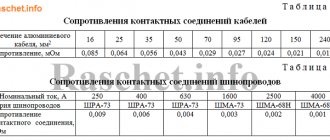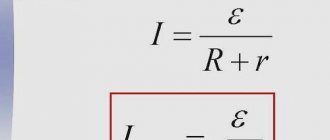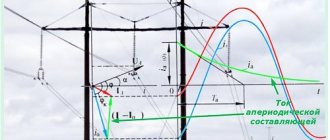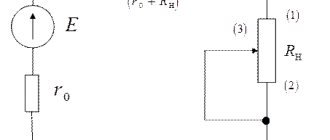Checking electronic equipment and all types of tires can be done in different ways. For example, to determine the degree of electrodynamic stability, a short-circuit shock current (isp) is used, the value of which is determined by calculations. At its core, this value is the maximum instantaneous value of the total short-circuit current. This characteristic can be calculated at the stage between the absence of current in the previous mode and the maximum indicator of the aperiodic component.
Short circuit components
Before discussing the shock current, it is necessary to consider what parts the total short circuit current consists of. It is known that its main components are the free aperiodic part and the forced periodic component. The short-circuit current reaches its maximum level at the highest values of both components.
The aperiodic current at the very beginning of its appearance becomes maximum at the moment of zero current value in the previous mode, which is idle. Immediately upon the occurrence of a short circuit, the forced current with a periodic component passes its maximum level. This condition becomes an indicator used in calculations. The total short-circuit current with the maximum instantaneous value is the short-circuit shock current.
In practice, this indicator is calculated at the maximum value of the aperiodic part. For this purpose, the mode preceding the accident, called idle, is selected. This network condition is considered one of the most complex compared to inductive or active-inductive pre-emergency current, in which the aperiodic part will be lower.
The conditions under which the aperiodic component is formed are shown in the figure. They are completely dependent on the previous state of the current before the emergency mode. The red vector corresponds to the pre-emergency current, the blue vector to the periodic short-circuit current. The green vector shows the difference between them, indicating the magnitude of the aperiodic current in the initial stage.
ROOM ROOM ROOM
RESPONSIBILITY, RESPONSIBILITY µÐºÑÑиÑеÑкой Ñеп¸, он Ð²Ð¾Ð·Ð½Ð¸ÐºÐ°ÐµÑ ÑолÑко в ÑоР¼ ÑлÑÑае , ROCK ROOM пÑÑжение, ÑÑо Ñо же Ñамое). RESULTS ½Ð° пÑимеÑе водопада: еÑли еÑÑÑ ÑазноÑÑÑ ASSURANCE, RESEARCH, RESEARCH, RESEARCH ¸Ð¸, а когда Ð½ÐµÑ â она ÑÑÐ¾Ð¸Ñ Ð½Ð° меÑÑе. RESULTS SMALL ROOM ени е, и Ñем менÑÑе, Ñем вÑÑе ÑопÑоÑивление, вк RESULTS:
I = U/R,
remark:
I велиÑина Ñока, коÑоÑÑÑ Ð¸Ð½Ð¾Ð³Ð´Ð° назÑваÑÑ Â“Ñ ROOM µÐ²Ð¾Ð´ Ñ Ð½ÐµÐ¼ÐµÑкого ÑзÑка. ROSS (Р).
RESULTS RESEARCH RESULTS ¾Ð³Ð¾ замÑканиÑ. RESULTS Ñ ÑаÑÑо, ÑоÑÑ Ð¿ÑеподаваÑели некоÑоÑÑÑ Ð²Ñзов, Ñ SÑÐ »ÑÑав из ÑÑÑ ÑÑÑденÑа Ñлова «Ñила Ñока» ÑÑÑ Ð¶Ðµ ÑÑ RESULTS. “как же Ð¾Ð³Ð¾Ð½Ñ Ð¸ дÑм, идÑÑÑие Ð¾Ñ Ð¿Ñоводки What's wrong? â ÑпÑоÑÐ¸Ñ Ð½Ð°ÑÑÑÑнÑй оппоненÑ, — ÐÑо ли не Ñила? ÐÑÐ²ÐµÑ ÑÑо замеÑание еÑÑÑ. ROOM SÑеÑÑвÑеÑ, и нагÑев Ð¸Ñ Ð¾Ð±ÑÑловлен именно ÑÑÐ ¸Ð¼ ÑакÑом . R=0, R=0, R=0, R=0, R=0, R=0 ROOM · registry, regurgitation.
u registry . RESULTS (S RESTORATION, RESPONSE V). RESULTS ÐС).
R OPTIONAL RESEARCH Ð¸Ñ Ñока. У диÑлекÑÑиков (изолÑÑоÑов) оно болÑÑое, Ñо ÑÑ Ð¸ не беÑконеÑное, Ñ Ñ Ð¿Ñоводников â малоРµ. ROOM ÑделÑной велиÑинÑ. ROOM Ñе пÑÐ¾Ð²Ð¾Ð´Ð¸Ñ Ñок, а Ñем он длиннее, Ñем ÑÑже. RESULTS Ñ Ð² ÐмаÑ, ÑмноженнÑÑ Ð½Ð° квадÑаÑнÑй Ð¼Ð¸Ð»Ð»Ð¸Ð¼ÐµÑ Ñ Ð¸ д ROOM. RESULTS, RESPONSIBILITIES SMALL, SMALL, SMALL µ. 1 1 м ROOM 1 ROOM. 20 years ago 0.024 °.
RESULTS, Ð2 ¾Ð¿ÑоÑивление Ð ¸ÑÑоÑника напÑÑÐ¶ÐµÐ½Ð¸Ñ (ÐÐС).
Calculations of short-circuit shock current
Preliminary calculations show that the aperiodic component will take on its maximum initial value in the case when the phase voltage at the moment of switching on during a short circuit is equal to zero. In some cases, the voltage angle may exceed the zero mark.
At the same time, the phase of the periodic part will be equal to 90 degrees, and the current will begin to lose its maximum amplitude value. Consequently, there is a lag of the current from the voltage by just these 900. The reason for this condition is the active resistance of the short-circuited circuit with very small values.
When the phase voltage reaches 90 degrees, the current of the periodic component will leave the zero mark, which will lead to the fulfillment of the commutation law. In this case, there will be no aperiodic current, so no shock current will arise.
The figure below clearly shows the occurrence of a short circuit surge current, marked with a green curve. It has not yet reached the damping point, and the blue curve corresponding to the periodic current passes through it and the point of its amplitude value. In this case, both curves at this moment take on a common sign with a positive exponent. A similar situation occurs in the second half of the period from the beginning of the closure, that is, after approximately 0.01 s.
The surge current can be calculated using the following formula:
In which Ku is the shock coefficient, and Inmax is the amplitude value of the periodic short circuit current. Changes in Ku occur within the range of less than 1 and more than 2, while the electromagnetic time constant Ta can vary from 0 to infinity, characterizing the decay rate of the aperiodic component. As Ta decreases, the decay of the free component accelerates, and at the same time the shock coefficient decreases.
In high voltage networks it completely disappears after 0.1-0.3 seconds, and at low voltage attenuation also occurs very quickly due to the presence of high active network resistance.
Danger and consequences
Almost all short circuits lead to negative consequences of varying severity. In short, the greatest danger is a possible fire, which often turns into a full-fledged fire. In an emergency situation, the current strength increases significantly, and heat is released in large quantities in the conductors, which has a destructive effect on the insulation.
In most cases, especially in everyday life, when an arc short circuit occurs between the conductors and the fault point, a high-power electrical discharge is formed that can easily ignite nearby objects. The sudden release of current and heat poses a particular danger to people living in the house and operating personnel of enterprises.
Emergency situations with short circuits are called subsidence due to significant drops in voltage in a given network. Particularly large drawdowns form directly at the short circuit location. Such surges negatively affect electrical appliances and equipment, especially those with electric motors. Sensitive devices are often exposed to strong electromagnetic waves.
It is quite possible to prevent the destructive consequences defined by the term short circuits with the help of various protective equipment. They are determined at the design stage individually for each electrical installation.
Using the Impact Factor
The short-circuit shock factor plays an important role and should be considered in more detail. This indicator used in calculations can be expressed by a short formula: Ku = iy/inm. Here iy is the fault current and inm is the amplitude of the periodic component.
This coefficient is used when calculating the shock current. If in the formula the amplitude inm is replaced by the effective current, the following expression is obtained: Ку = iy√2inm. Consequently, the formula for calculating the shock current will take the following form: iy = Ку√2inm. In practice, the value of the short-circuit shock coefficient is taken as 1.8 in electrical installations of more than 1 kV; the value 1.3 is taken when a short circuit occurs behind a section of a long cable line.
The same indicator is used for the secondary side of a step-down transformer with a power not exceeding 1000 kVA and networks with voltages up to 1 kV. To speed up calculations, there is a table containing coefficients for emergency situations that occur most often.
| Equipment and installations | Time constant Ta | Shock coefficient Ku |
| Turbogenerators | 0,1-0,3 | 1,95 |
| A block consisting of a generator and a transformer | 0,04 | 1,8 |
| High voltage power line | 0,01 | 1,3 |
| Short low-voltage power line | 0,001 | – |
Theoretically, in the absence of active resistances and a time constant equal to infinity in the circuit, attenuation of the periodic component would not occur at all, and it would retain its initial value for the entire short circuit period until the emergency section is turned off. In this case, the shock coefficient would reach its maximum and amount to Ku = 2.
If a short circuit occurs in places far away from the power source, the currents appearing at this point will be small compared to the rated current of this power source. During the short circuit, changes in the nominal value will be almost imperceptible, and the voltage at the terminals should be taken as a constant value.
Scheme
Another way to study the principle of current action is to build a circuit. At the moment, you can use a special program for this. Thanks to it, you can not only understand in what situation a short circuit will occur, but also try to prevent it by building the correct electrical circuit and then using high-quality materials.
Note! It is worth pointing out that in addition to the remote method, it is possible to make the circuit yourself using the appropriate tutorials. As a result of this action, it is possible to check the input circuit breaker, which has an average rated current for the switching capacity in the power cable line
Thanks to the circuit, it will be easy to determine in current values.
Electric current diagram
In general, short-circuit electric current is destructive energy, which depends on the number of photons, emission spectrum, optical properties, and other things. Its power can be measured using a special formula. It has its own schedule and diagram, which are presented above.
Protection methods
In the very first years of the rapid development of electrical engineering, when humanity was still bravely experimenting, introducing galvanic devices, inventing various types of generators, motors and lighting, the problem arose of protecting these devices from overloads and short-circuit currents. The simplest solution was to install fusible elements in series with the load, which were destroyed under the influence of resistive heat if the current exceeded the set value. Such fuses still serve people today; their main advantages are simplicity, reliability and low cost. But they also have disadvantages. The very simplicity of the “plug” (as the holders of fusible rates called it for their specific shape) provokes users after it burns out not to philosophize, but to replace the failed elements with the first wires, paper clips, or even nails that come to hand. Is it worth mentioning that such protection against short-circuit currents does not fulfill its noble function?
In industrial enterprises, automatic switches began to be used to de-energize overloaded circuits earlier than in residential switchboards, but in recent decades, “traffic jams” have been largely replaced by them. “Automatic machines” are much more convenient; you don’t have to change them, but turn them on after eliminating the cause of the short circuit and waiting for the thermal elements to cool down. Their contacts sometimes burn out, in which case it is better to replace them and not try to clean or repair them. More complex differential circuit breakers, at a high cost, do not last longer than conventional ones, but their functional load is wider; they turn off the voltage in the event of minimal current leakage “to the side”, for example, when a person is electrocuted.
In everyday life, experimenting with short circuits is not recommended.
Causes of the dangerous situation
An emergency situation and a short circuit cannot occur just like that.
In each specific case there are certain reasons and negative factors:
- High voltage level when closing. Usually occurs as a result of a sharp jump in which all permissible norms are exceeded. The probability of breakdown of insulation or the entire circuit becomes very high. Current leakage increases with a simultaneous increase in arc temperature. During a short circuit, high voltage always creates a short-term arc discharge.
- Old worn layers of insulation coating. Such situations most often occur when wiring has not been replaced for a long time. Weak insulation turns out to be the most susceptible to electrical breakdown, the reason for which is the exhaustion of its resource.
- External mechanical influences. The protective sheath of the conductors is gradually frayed, and the insulating coating is damaged. Wire strands are also susceptible to damage, causing not only short circuits, but also fires.
- Sometimes foreign objects - dust, debris, etc. - get into the electrical circuit. When they hit a conductor, they create their own additional circuit that can cause a short circuit current in the source.
- Lightning strikes that create high voltages that easily penetrate an entire electrical circuit or conductor insulation.
Two simple but important formulas
It is impossible to understand the reason why short-circuit current occurs without mastering another simple formula. The power consumed by the load is equal (without taking into account reactive components, but more on them later) the product of current and voltage.
P = U x I,
Where:
P – power, Watt or Volt-Ampere;
U – voltage, Volt;
I – current, Ampere.
Power is never infinite, it is always limited by something, therefore, with its fixed value, as the current increases, the voltage decreases. The dependence of these two parameters of the operating circuit, expressed graphically, is called the current-voltage characteristic.
And one more formula necessary to calculate short-circuit currents is the Joule-Lenz law. It gives an idea of how much heat is generated when resisting a load, and is very simple. The conductor will heat up with an intensity proportional to the voltage and square of the current. And, of course, the formula is not complete without time; the longer the resistance heats up, the more heat it will release.










